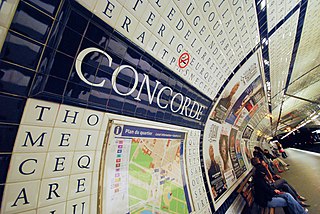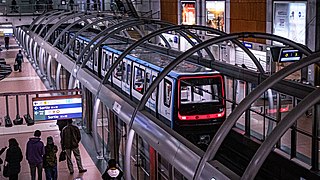
The Paris Métro, operated by the Régie autonome des transports parisiens (RATP), is a rapid transit system in the Paris metropolitan area, France. A symbol of the city, it is known for its density within the capital's territorial limits, uniform architecture and unique historical entrances influenced by Art Nouveau. The system is 226.9 kilometres (141.0 mi) long, mostly underground. It has 308 stations of which 64 have transfers between lines. There are 16 lines, numbered 1 to 14, with two lines, Line 3bis and Line 7bis, named because they used to be part of Line 3 and Line 7, respectively. Line 1, Line 4 and Line 14 are automated. Lines are identified on maps by number and colour, with the direction of travel indicated by the terminus.

The RATP Group, is a French state-owned enterprise (EPIC) that operates public transport systems. It is headquartered in Paris, France, and originally operated under the name Régie autonome des transports parisiens. Its logo represents, in a stylized version, the Seine's meandering through the Paris area as the face of a person looking up. The company had described itself as the fourth-largest presence in public transport.

Anvers is a station on Line 2 of the Paris Métro. It is located in Montmartre, on the border of the 9th and the 18th arrondissements.

Paris Métro Line 14 is one of the sixteen lines on the Paris Métro. It connects the stations Mairie de Saint-Ouen and Olympiades on a north-west south-east diagonal via the three major stations of Gare Saint-Lazare, the Châtelet–Les-Halles complex, and Gare de Lyon. The line goes through the centre of Paris, and reaches the communes of Saint-Ouen-sur-Seine and Clichy.

The Lyon Metro is a rapid transit system serving Lyon Metropolis, France. First opened in 1974, it currently consists of four lines, serving 42 stations and comprising 34.4 kilometres (21.4 mi) of route. Part of the Transports en Commun Lyonnais (TCL) system of public transport, it is supported by two funiculars and a tramway network.

Paris Métro Line 1 is one of the sixteen lines of the Paris Métro. It connects La Défense in the northwest and Château de Vincennes in the southeast. With a length of 16.5 km (10.3 mi), it constitutes an important east–west transportation route within the City of Paris. Excluding Réseau Express Régional (RER) commuter lines, it is the busiest line on the network with 181.2 million travellers in 2017 or 496,000 people per day on average.
Paris Métro Line 11 is one of the sixteen lines of the Paris Métro. It links Châtelet to Mairie des Lilas in the northeastern suburbs. At a length of 6.3 km (3.9 mi) and 13 stations served, it is currently the shortest of the 14 main Métro lines but is being extended by 6 stations. With 47.1 million riders in 2017, it is the thirteenth busiest line in the network.

Paris Métro Line 12 is one of the sixteen lines of the Paris Métro. It links Issy-les-Moulineaux, a suburban town southwest of Paris, to Aubervilliers, in the north. With around 54 million passengers per year, Line 12 was the twelfth busiest line of the network in 2021. It has several major stops, such as Madeleine, Concorde, Porte de Versailles and two national railway stations, Gare Montparnasse and Gare Saint-Lazare. The service runs every day of the week, and the line uses MF 67 series trains, the network's standard since the early 1970s.

Line C of the Lyon Metro is the modern incarnation of the Funiculaire Croix-Rousse – Croix-Paquet, an old cable-hauled railway operating on part of the current alignment.
The Funiculars of Lyon is a network of funicular railways in Lyon, France. Of the five lines once in existence, only the two routes on the Fourvière hill remain in operation, with the rest of the network now either closed, converted to road vehicle use, or integrated within the Lyon underground system.

The Lausanne Métro system is a two-line urban rail transport system in Lausanne, Vaud, Switzerland. Around a quarter of the system has been used for urban rail transport since 1877, when the route between the city centre and Ouchy opened as Switzerland's first public funicular railway. The network is owned by two distinct companies and operated by a third.

The Old Quebec Funicular is an inclined elevator, formerly a funicular railway, in the Old Quebec neighbourhood of Quebec City, Quebec, Canada. It links the Haute-Ville at Dufferin Terrace to the Basse-Ville at Rue du Petit-Champlain. The Basse-Ville includes such sites as the colonial-era Notre Dame des Victoires church, the historic Petit Champlain district, the port, and the Musée de la civilisation. Climbing at a 45-degree angle, the railway covers a total distance of 64 metres (210 ft).

Île-de-France tramway lines 3a and 3b are the first modern tramway in Paris proper since the 1937 closure of the previous comparable system. They are operated by the RATP and divided into two sections called T3a and T3b. The line is also known as the Tramway des Maréchaux because it follows the Boulevards of the Marshals, a series of boulevards that encircle Paris along the route of the former Thiers Wall. The boulevards are, with three exceptions, named for Napoleon's First Empire marshals (maréchaux); they were transformed by redevelopment works carried out during the two and a half year construction of the line, which opened on 16 December 2006 under the designation T3.

The Les Avants–Sonloup funicular is a metre gauge funicular railway in the Swiss canton of Vaud. It links the railway station of Les Avants, on the Montreux–Lenk im Simmental line between Montreux and Montbovon, with an upper terminus at Sonloup.

The Bellevue funicular, in Meudon, Hauts-de-Seine department, was from 1893 to 1934 a funicular running from the Bellevue-Funiculaire station on the Coteaux line, to the Gare de Bellevue, on the Paris–Brest railway line.

The Belleville funicular tramway was a cable car which from 1891 to 1924 connected the Place de la République in Paris to the Église Saint-Jean-Baptiste de Belleville, on a hill in the Belleville quarter. It has since been demolished.

The MP 14 is a rubber-tyred electric multiple unit for the Paris Métro. Manufactured by Alstom as part of the Alstom Metropolis family of units, it is the seventh generation of the rubber-tyred class of trains to be used on the system and is used on Line 14, Line 4 and Line 11. In future, trains could be ordered for Line 1 and Line 6.

An inclined elevator or inclined lift is a form of cable railway that hauls rail cars up a steep gradient.

The Grand Paris Express is a project consisting of new rapid transit lines and the extension of existing lines being built in the Île-de-France region of France. The project comprises four new lines for the Paris Métro, plus extensions of the existing lines 11 and 14. A total of 200 kilometres (120 mi) of new tracks and 68 new stations are to be added, serving a projected 2 million passengers a day.
























